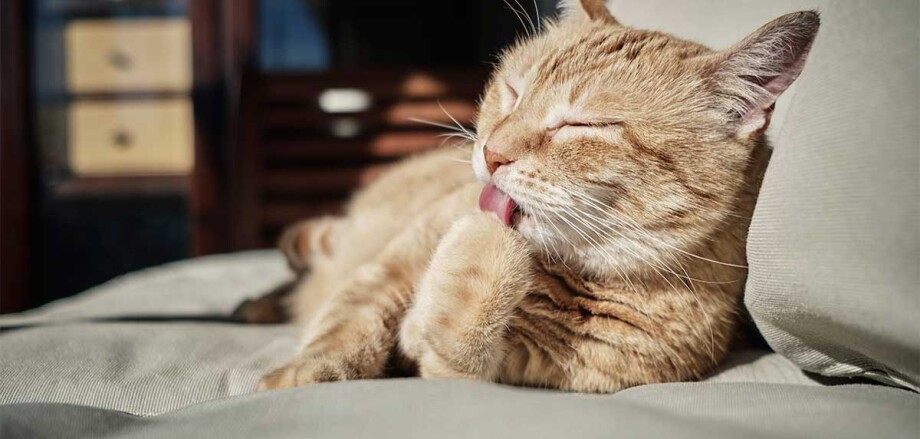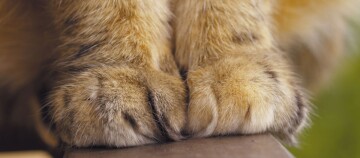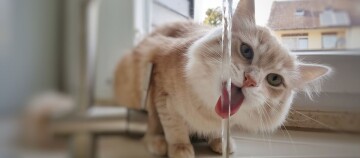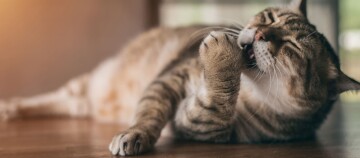Drooling cat – When to worry?
21.12.2023 - Reading time: 7 minutes

A cat can start drooling for a variety of reasons. This can be harmless, but can also pose a serious health risk.
You're stroking your little feline when they suddenly start drooling. This unusual behaviour in your cat probably worries you and you’d like to know whether it’s serious or not. The reasons why a cat drools are varied. Is the cat drooling foam? Very liquid saliva? Is hypersalivation accompanied by other symptoms?
What to do when a cat drools?
Excessive drooling, also called hypersalivation or ptyalism, may be a sign of illness, intoxication or could have an emotional cause. The consistency and smell of the drool can help to establish a diagnosis and may give the owner cause for concern. You should get an appointment with your vet as quickly as possible in the following cases:
- A cat that drools and vomits
- Hypersalivation with pink or red drool
- White, foul-smelling salivary fluid
- Your cat is having convulsions
- A sudden fever in your little feline
- Your cat is having breathing difficulties and is panting
- Their pupils are dilated
In some cases, acting quickly will mean saving your little furball’s life. This is particularly the case if your cat has been poisoned.
Cat that drools a lot suddenly
When a cat that has been in good health until now and shows no other symptoms suddenly salivates more than usual, this may be a sign of poisoning. A cat that goes out is more exposed to this risk, but even house cats can come into contact with a toxic substance.
Some of the most common are:
As well as hypersalivation, the cat may experience symptoms such as vomiting, diarrhoea, respiratory problems, convulsions and a bluish tinge to the mucous membranes. If you think your cat has been poisoned, avoid any form of self-medication. Do not try to make them vomit and do not give them milk. This could make the situation worse. Call your nearest vet as quickly as possible, try to stay calm and follow the advice they give you over the phone. If you know that the cause of poisoning is a certain product, take it with you to show the vet. Make sure it’s not within reach of your cat in the car.
Drooling cat – coryza or cat flu
Coryza, also called cat flu, is a fairly common disease among these small felines and unfortunately can sometimes be fatal, especially in kittens. Extremely contagious, it is most often spread between cats via the mouth and nose. It can be viral or bacterial. In addition to hypersalivation, there are a number of other symptoms:
- a runny nose
- sneezing
- watery eyes
- loss of appetite
- fever
- a cough
- breathing difficulties
This is also an emergency and you should contact your veterinary clinic. If coryza is not treated, it may sometimes lead to pneumonia and blindness. In order to protect your little companion, you can vaccinate them as soon as they are weaned. Vaccinated cats may still be carriers of the illness without having symptoms.
Cat drooling white foam
First of all, you need to differentiate between a cat that drools foam and one that vomits white foam. In the second case, gastric juices are involved, and the causes range from gastrointestinal disease to pancreatitis, diabetes and liver failure, for example. In the first case, your cat may drool white foam after taking medication. If it happens again, seek advice from your vet. Anti-parasite treatment can also be the cause of your little feline’s hypersalivation. Make sure the contents are in a place your cat can’t reach with its tongue. If you have several cats, separate them during the hours after the anti-parasite treatment to prevent them from licking each other. If in doubt, it is always best to take your cat to a vet who will identify the exact cause of his hypersalivation. Some owners report a cat with sticky drool after they’ve used a flea spray inside their home. If you want to treat the carpets, baskets and nooks and crannies of your flat or house, take your cat out before doing so and stay out for a while yourself. Natural products like diatomaceous earth provide good results in preventing fleas and are not harmful to your small pet.
Drooling cat: illness or something else?
A cat that drools a lot is not necessarily ill. If your cat’s drool has a bad smell, it could be due to oral problems. Inflammation caused by too much tartar on the animal’s teeth leads to excessive salivation and reddening of the gums. In addition to dental problems, a cat that drools and has stopped eating may have been stung by an insect inside its mouth. If your little feline goes out, you have probably already seen them trying to catch a bee or a wasp. The sting is painful, may swell and, depending on where it is in the mouth, may cause difficulty in swallowing or even breathing. A cat that drools and is weak may be suffering from heatstroke. Although most cats seek shade or return home in hot weather, some continue to chase mice. Heatstroke is a life-threatening emergency for your little feline! If your cat has been in the sun for too long, starts drooling, trembling or loses consciousness, call your vet immediately. They will tell you what to do, how to cool your cat down and bring them to the clinic safely.
Mouth ulcers, cause of hypersalivation
An ulcer can develop on a cat’s palate, tongue or gums. This leads to a lack of appetite and a tendency to drool excessively, especially if the ulcer is on the tongue. If your cat lets you look inside their mouth, you may see something that resembles a mouth ulcer in humans. Take care not to touch this painful ulcer. Your pet may react by biting you, even if they are usually gentle with you. A mouth ulcer is often one of the symptoms of calicivirus, an upper respiratory tract infection caused by feline calicivirus. Other symptoms of this disease include: nasal congestion, eye inflammation, sneezing and runny eyes and nose. To rule out any underlying disease, it’s best to consult a vet when your cat is suffering from mouth ulcers. They will also tell you what to do to prevent these ulcers. Professional dental cleaning and regular brushing of your little feline’s teeth with a cat toothpaste will reduce the risk of mouth ulcers. Wait until your cat is feeling better before doing so in order to avoid pain, and follow your vet’s instructions.
Cat that drools when cuddled
A cat that drools when it purrs is probably extremely relaxed and appreciative of the petting you are giving it. Although purring does not always mean that a cat is happy, when it is accompanied by hypersalivation, the chances are that your beloved feline is in heaven. If they are drooling all over your clean blouse or the sofa, that’s obviously pretty unpleasant for you, but take comfort in the fact that your little friend is happy right now. If they do it often, simply have a towel or roll of paper towels to hand. A cat that drools while sleeping is no doubt having sweet dreams and catching mice in the land of milk and honey. Beware, however, that purring can also occur in the event of pain or stress. It helps the cat relax and soothe themself. Look at their body language to better understand their purring. If they are wagging their tail, it’s best to stop stroking them. That’s apparently not what they need. Does your cat have any other symptoms apart from purring, such as sickness and diarrhoea? Do they tend to withdraw into a quiet corner and avoid contact with you and other members of the family? Cats are complex animals and it is sometimes difficult to know if they are well or not. With time, you will learn to recognise the signs that tell you if something is affecting your adorable furball.


